Wireless Networks: Exploring Antenna Types, Protocols, and Security
VerifiedAdded on 2023/06/08
|8
|1203
|219
Report
AI Summary
This report provides an overview of wireless networks, focusing on different antenna types such as Yagi-Uda, horn, and cellular antennas, detailing their strengths and weaknesses, and discussing their potential future roles in wireless communication. It also examines various wireless network protocols, including Bluetooth, Wi-Fi, and LTE, highlighting their advantages, disadvantages, and security challenges. The report concludes by addressing the threats and challenges associated with wireless networks, such as data security, cyber-attacks, and reduced data speeds. It references multiple sources to support its analysis of these technologies.

Wireless networks
Paraphrase This Document
Need a fresh take? Get an instant paraphrase of this document with our AI Paraphraser
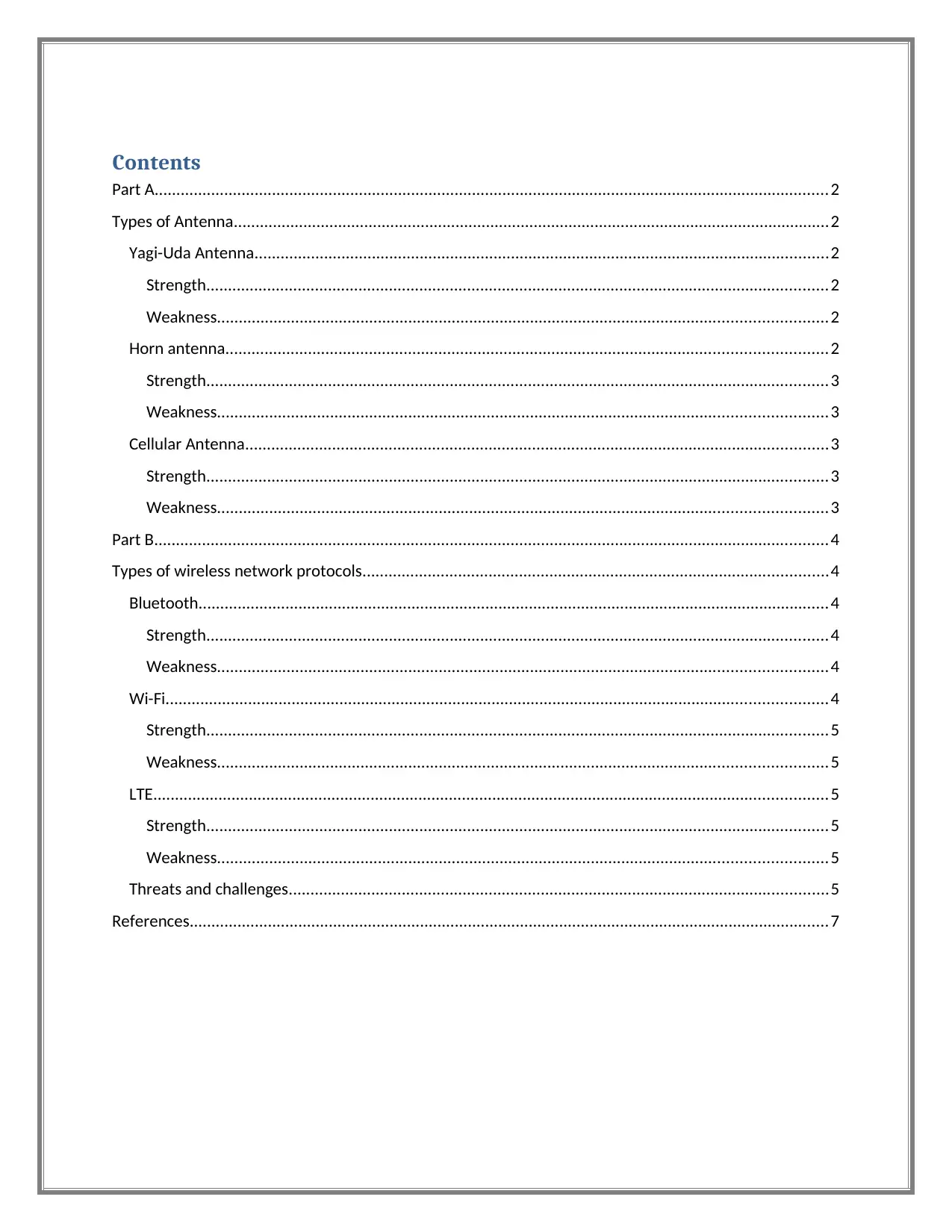
Contents
Part A...........................................................................................................................................................2
Types of Antenna.........................................................................................................................................2
Yagi-Uda Antenna....................................................................................................................................2
Strength...............................................................................................................................................2
Weakness............................................................................................................................................2
Horn antenna..........................................................................................................................................2
Strength...............................................................................................................................................3
Weakness............................................................................................................................................3
Cellular Antenna......................................................................................................................................3
Strength...............................................................................................................................................3
Weakness............................................................................................................................................3
Part B...........................................................................................................................................................4
Types of wireless network protocols...........................................................................................................4
Bluetooth.................................................................................................................................................4
Strength...............................................................................................................................................4
Weakness............................................................................................................................................4
Wi-Fi........................................................................................................................................................4
Strength...............................................................................................................................................5
Weakness............................................................................................................................................5
LTE...........................................................................................................................................................5
Strength...............................................................................................................................................5
Weakness............................................................................................................................................5
Threats and challenges............................................................................................................................5
References...................................................................................................................................................7
Part A...........................................................................................................................................................2
Types of Antenna.........................................................................................................................................2
Yagi-Uda Antenna....................................................................................................................................2
Strength...............................................................................................................................................2
Weakness............................................................................................................................................2
Horn antenna..........................................................................................................................................2
Strength...............................................................................................................................................3
Weakness............................................................................................................................................3
Cellular Antenna......................................................................................................................................3
Strength...............................................................................................................................................3
Weakness............................................................................................................................................3
Part B...........................................................................................................................................................4
Types of wireless network protocols...........................................................................................................4
Bluetooth.................................................................................................................................................4
Strength...............................................................................................................................................4
Weakness............................................................................................................................................4
Wi-Fi........................................................................................................................................................4
Strength...............................................................................................................................................5
Weakness............................................................................................................................................5
LTE...........................................................................................................................................................5
Strength...............................................................................................................................................5
Weakness............................................................................................................................................5
Threats and challenges............................................................................................................................5
References...................................................................................................................................................7
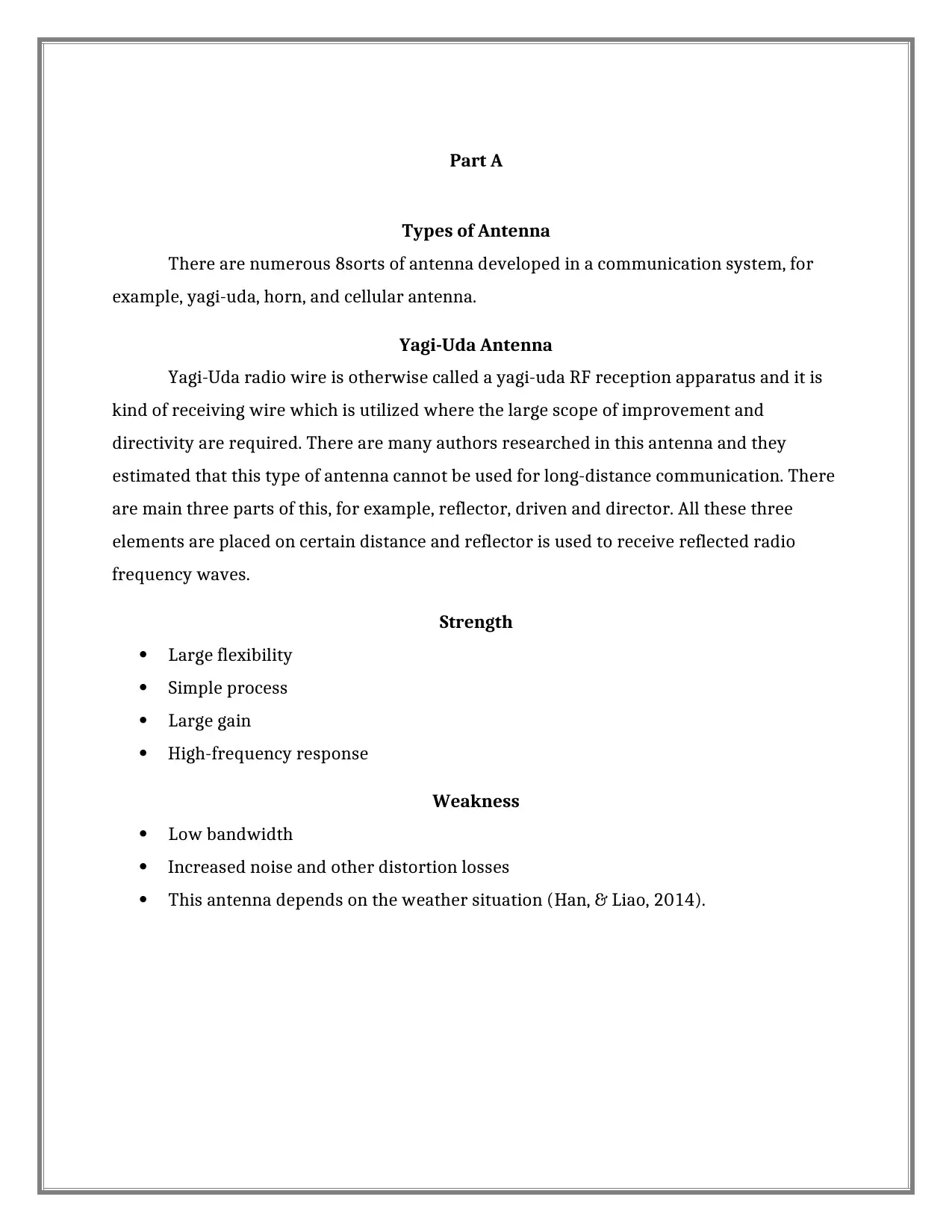
Part A
Types of Antenna
There are numerous 8sorts of antenna developed in a communication system, for
example, yagi-uda, horn, and cellular antenna.
Yagi-Uda Antenna
Yagi-Uda radio wire is otherwise called a yagi-uda RF reception apparatus and it is
kind of receiving wire which is utilized where the large scope of improvement and
directivity are required. There are many authors researched in this antenna and they
estimated that this type of antenna cannot be used for long-distance communication. There
are main three parts of this, for example, reflector, driven and director. All these three
elements are placed on certain distance and reflector is used to receive reflected radio
frequency waves.
Strength
Large flexibility
Simple process
Large gain
High-frequency response
Weakness
Low bandwidth
Increased noise and other distortion losses
This antenna depends on the weather situation (Han, & Liao, 2014).
Types of Antenna
There are numerous 8sorts of antenna developed in a communication system, for
example, yagi-uda, horn, and cellular antenna.
Yagi-Uda Antenna
Yagi-Uda radio wire is otherwise called a yagi-uda RF reception apparatus and it is
kind of receiving wire which is utilized where the large scope of improvement and
directivity are required. There are many authors researched in this antenna and they
estimated that this type of antenna cannot be used for long-distance communication. There
are main three parts of this, for example, reflector, driven and director. All these three
elements are placed on certain distance and reflector is used to receive reflected radio
frequency waves.
Strength
Large flexibility
Simple process
Large gain
High-frequency response
Weakness
Low bandwidth
Increased noise and other distortion losses
This antenna depends on the weather situation (Han, & Liao, 2014).
⊘ This is a preview!⊘
Do you want full access?
Subscribe today to unlock all pages.

Trusted by 1+ million students worldwide
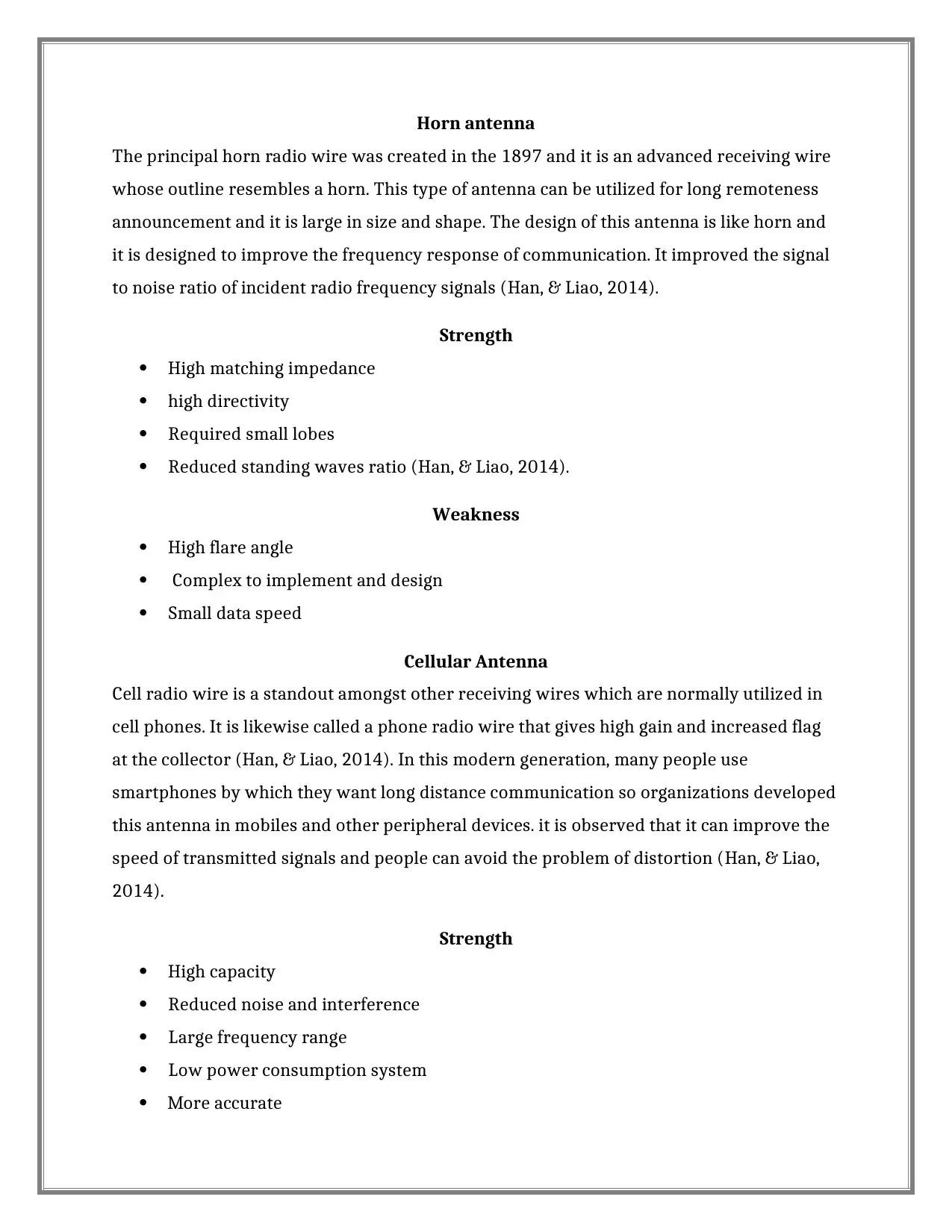
Horn antenna
The principal horn radio wire was created in the 1897 and it is an advanced receiving wire
whose outline resembles a horn. This type of antenna can be utilized for long remoteness
announcement and it is large in size and shape. The design of this antenna is like horn and
it is designed to improve the frequency response of communication. It improved the signal
to noise ratio of incident radio frequency signals (Han, & Liao, 2014).
Strength
High matching impedance
high directivity
Required small lobes
Reduced standing waves ratio (Han, & Liao, 2014).
Weakness
High flare angle
Complex to implement and design
Small data speed
Cellular Antenna
Cell radio wire is a standout amongst other receiving wires which are normally utilized in
cell phones. It is likewise called a phone radio wire that gives high gain and increased flag
at the collector (Han, & Liao, 2014). In this modern generation, many people use
smartphones by which they want long distance communication so organizations developed
this antenna in mobiles and other peripheral devices. it is observed that it can improve the
speed of transmitted signals and people can avoid the problem of distortion (Han, & Liao,
2014).
Strength
High capacity
Reduced noise and interference
Large frequency range
Low power consumption system
More accurate
The principal horn radio wire was created in the 1897 and it is an advanced receiving wire
whose outline resembles a horn. This type of antenna can be utilized for long remoteness
announcement and it is large in size and shape. The design of this antenna is like horn and
it is designed to improve the frequency response of communication. It improved the signal
to noise ratio of incident radio frequency signals (Han, & Liao, 2014).
Strength
High matching impedance
high directivity
Required small lobes
Reduced standing waves ratio (Han, & Liao, 2014).
Weakness
High flare angle
Complex to implement and design
Small data speed
Cellular Antenna
Cell radio wire is a standout amongst other receiving wires which are normally utilized in
cell phones. It is likewise called a phone radio wire that gives high gain and increased flag
at the collector (Han, & Liao, 2014). In this modern generation, many people use
smartphones by which they want long distance communication so organizations developed
this antenna in mobiles and other peripheral devices. it is observed that it can improve the
speed of transmitted signals and people can avoid the problem of distortion (Han, & Liao,
2014).
Strength
High capacity
Reduced noise and interference
Large frequency range
Low power consumption system
More accurate
Paraphrase This Document
Need a fresh take? Get an instant paraphrase of this document with our AI Paraphraser
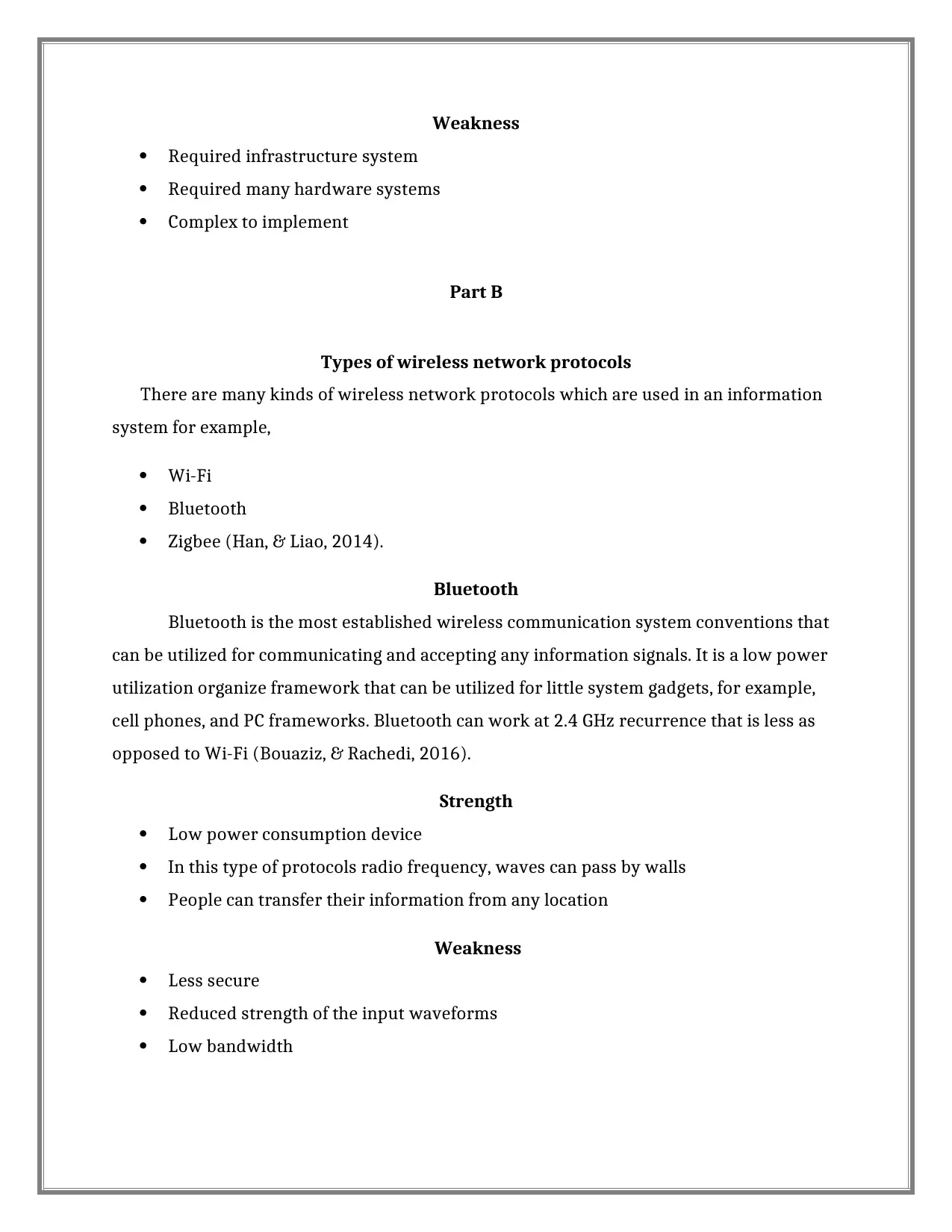
Weakness
Required infrastructure system
Required many hardware systems
Complex to implement
Part B
Types of wireless network protocols
There are many kinds of wireless network protocols which are used in an information
system for example,
Wi-Fi
Bluetooth
Zigbee (Han, & Liao, 2014).
Bluetooth
Bluetooth is the most established wireless communication system conventions that
can be utilized for communicating and accepting any information signals. It is a low power
utilization organize framework that can be utilized for little system gadgets, for example,
cell phones, and PC frameworks. Bluetooth can work at 2.4 GHz recurrence that is less as
opposed to Wi-Fi (Bouaziz, & Rachedi, 2016).
Strength
Low power consumption device
In this type of protocols radio frequency, waves can pass by walls
People can transfer their information from any location
Weakness
Less secure
Reduced strength of the input waveforms
Low bandwidth
Required infrastructure system
Required many hardware systems
Complex to implement
Part B
Types of wireless network protocols
There are many kinds of wireless network protocols which are used in an information
system for example,
Wi-Fi
Bluetooth
Zigbee (Han, & Liao, 2014).
Bluetooth
Bluetooth is the most established wireless communication system conventions that
can be utilized for communicating and accepting any information signals. It is a low power
utilization organize framework that can be utilized for little system gadgets, for example,
cell phones, and PC frameworks. Bluetooth can work at 2.4 GHz recurrence that is less as
opposed to Wi-Fi (Bouaziz, & Rachedi, 2016).
Strength
Low power consumption device
In this type of protocols radio frequency, waves can pass by walls
People can transfer their information from any location
Weakness
Less secure
Reduced strength of the input waveforms
Low bandwidth
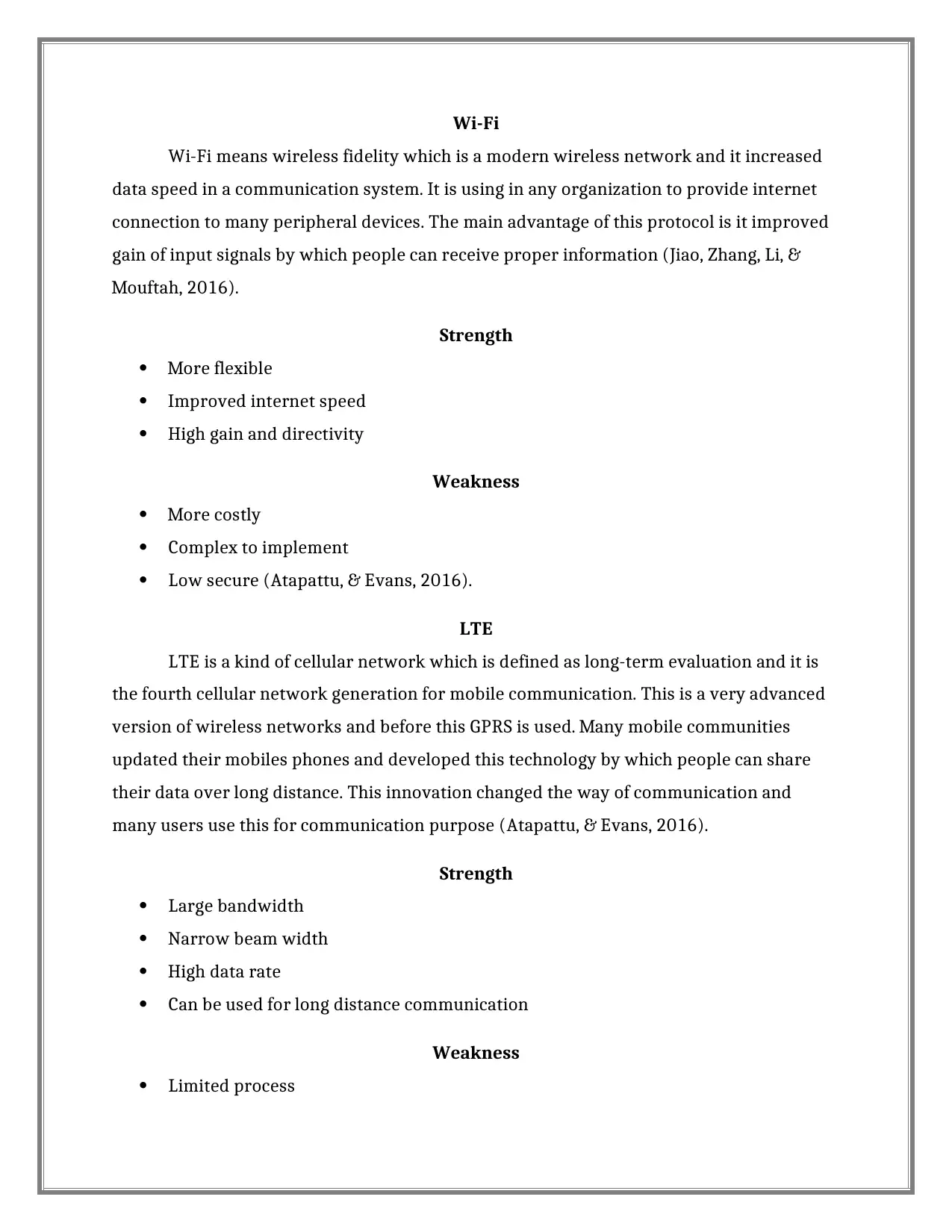
Wi-Fi
Wi-Fi means wireless fidelity which is a modern wireless network and it increased
data speed in a communication system. It is using in any organization to provide internet
connection to many peripheral devices. The main advantage of this protocol is it improved
gain of input signals by which people can receive proper information (Jiao, Zhang, Li, &
Mouftah, 2016).
Strength
More flexible
Improved internet speed
High gain and directivity
Weakness
More costly
Complex to implement
Low secure (Atapattu, & Evans, 2016).
LTE
LTE is a kind of cellular network which is defined as long-term evaluation and it is
the fourth cellular network generation for mobile communication. This is a very advanced
version of wireless networks and before this GPRS is used. Many mobile communities
updated their mobiles phones and developed this technology by which people can share
their data over long distance. This innovation changed the way of communication and
many users use this for communication purpose (Atapattu, & Evans, 2016).
Strength
Large bandwidth
Narrow beam width
High data rate
Can be used for long distance communication
Weakness
Limited process
Wi-Fi means wireless fidelity which is a modern wireless network and it increased
data speed in a communication system. It is using in any organization to provide internet
connection to many peripheral devices. The main advantage of this protocol is it improved
gain of input signals by which people can receive proper information (Jiao, Zhang, Li, &
Mouftah, 2016).
Strength
More flexible
Improved internet speed
High gain and directivity
Weakness
More costly
Complex to implement
Low secure (Atapattu, & Evans, 2016).
LTE
LTE is a kind of cellular network which is defined as long-term evaluation and it is
the fourth cellular network generation for mobile communication. This is a very advanced
version of wireless networks and before this GPRS is used. Many mobile communities
updated their mobiles phones and developed this technology by which people can share
their data over long distance. This innovation changed the way of communication and
many users use this for communication purpose (Atapattu, & Evans, 2016).
Strength
Large bandwidth
Narrow beam width
High data rate
Can be used for long distance communication
Weakness
Limited process
⊘ This is a preview!⊘
Do you want full access?
Subscribe today to unlock all pages.

Trusted by 1+ million students worldwide
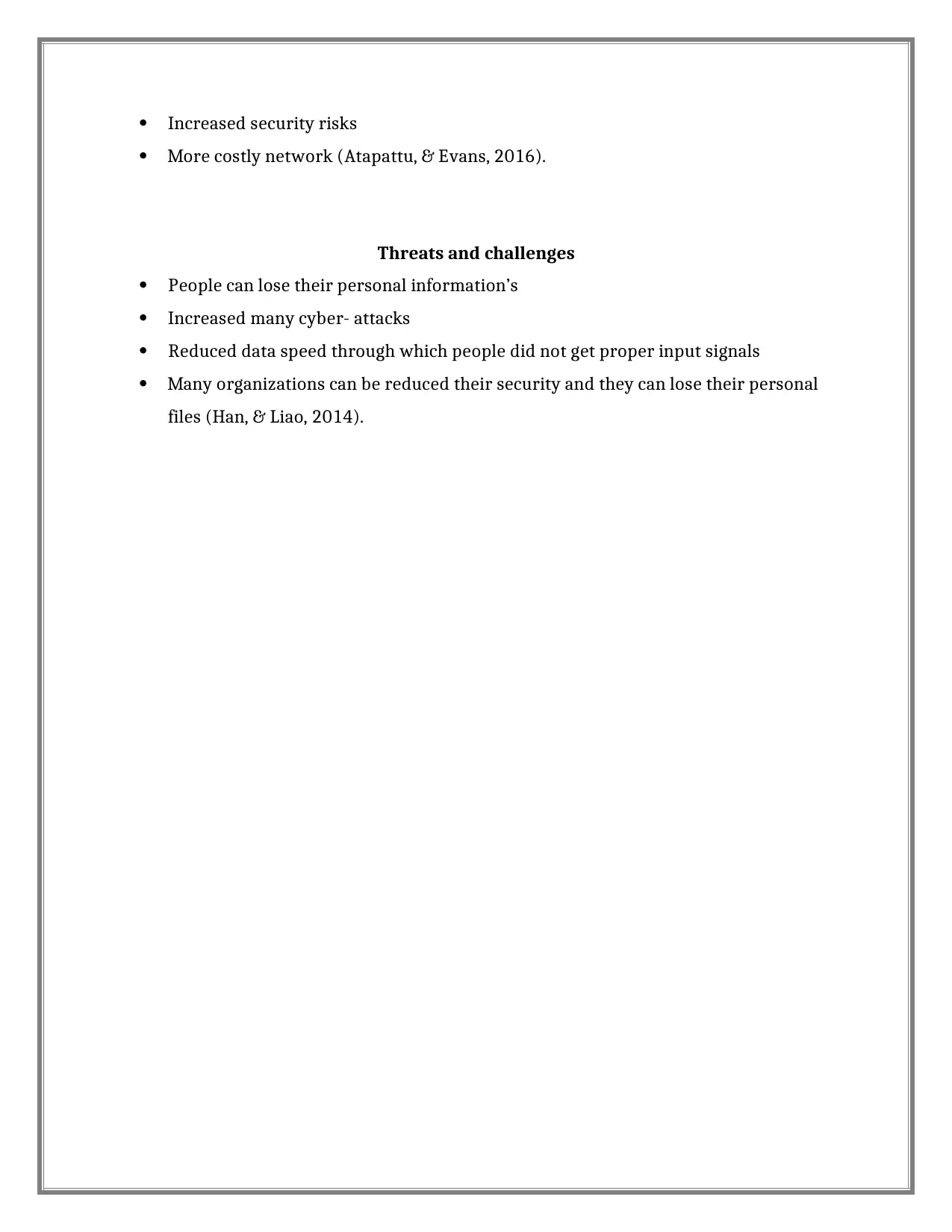
Increased security risks
More costly network (Atapattu, & Evans, 2016).
Threats and challenges
People can lose their personal information’s
Increased many cyber- attacks
Reduced data speed through which people did not get proper input signals
Many organizations can be reduced their security and they can lose their personal
files (Han, & Liao, 2014).
More costly network (Atapattu, & Evans, 2016).
Threats and challenges
People can lose their personal information’s
Increased many cyber- attacks
Reduced data speed through which people did not get proper input signals
Many organizations can be reduced their security and they can lose their personal
files (Han, & Liao, 2014).
Paraphrase This Document
Need a fresh take? Get an instant paraphrase of this document with our AI Paraphraser
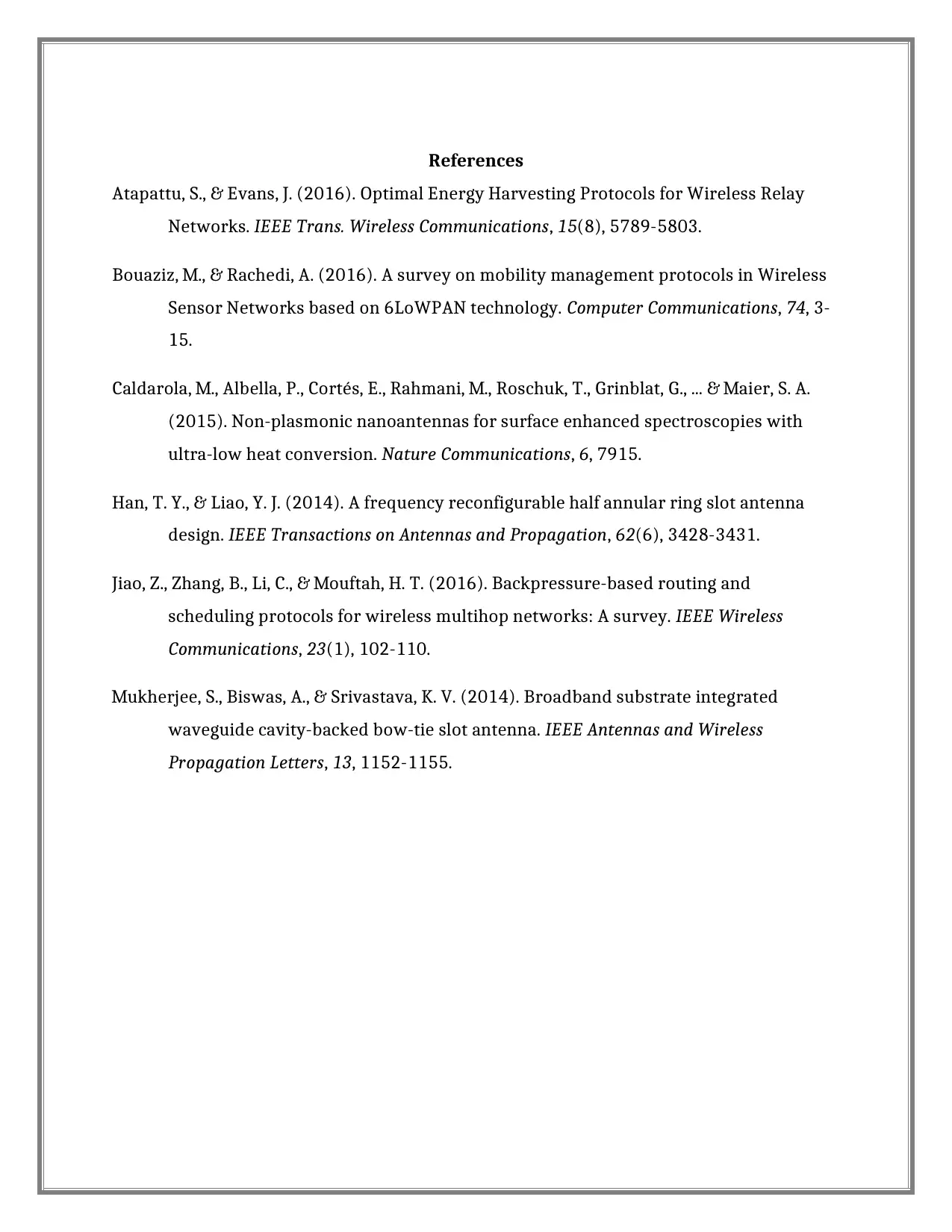
References
Atapattu, S., & Evans, J. (2016). Optimal Energy Harvesting Protocols for Wireless Relay
Networks. IEEE Trans. Wireless Communications, 15(8), 5789-5803.
Bouaziz, M., & Rachedi, A. (2016). A survey on mobility management protocols in Wireless
Sensor Networks based on 6LoWPAN technology. Computer Communications, 74, 3-
15.
Caldarola, M., Albella, P., Cortés, E., Rahmani, M., Roschuk, T., Grinblat, G., ... & Maier, S. A.
(2015). Non-plasmonic nanoantennas for surface enhanced spectroscopies with
ultra-low heat conversion. Nature Communications, 6, 7915.
Han, T. Y., & Liao, Y. J. (2014). A frequency reconfigurable half annular ring slot antenna
design. IEEE Transactions on Antennas and Propagation, 62(6), 3428-3431.
Jiao, Z., Zhang, B., Li, C., & Mouftah, H. T. (2016). Backpressure-based routing and
scheduling protocols for wireless multihop networks: A survey. IEEE Wireless
Communications, 23(1), 102-110.
Mukherjee, S., Biswas, A., & Srivastava, K. V. (2014). Broadband substrate integrated
waveguide cavity-backed bow-tie slot antenna. IEEE Antennas and Wireless
Propagation Letters, 13, 1152-1155.
Atapattu, S., & Evans, J. (2016). Optimal Energy Harvesting Protocols for Wireless Relay
Networks. IEEE Trans. Wireless Communications, 15(8), 5789-5803.
Bouaziz, M., & Rachedi, A. (2016). A survey on mobility management protocols in Wireless
Sensor Networks based on 6LoWPAN technology. Computer Communications, 74, 3-
15.
Caldarola, M., Albella, P., Cortés, E., Rahmani, M., Roschuk, T., Grinblat, G., ... & Maier, S. A.
(2015). Non-plasmonic nanoantennas for surface enhanced spectroscopies with
ultra-low heat conversion. Nature Communications, 6, 7915.
Han, T. Y., & Liao, Y. J. (2014). A frequency reconfigurable half annular ring slot antenna
design. IEEE Transactions on Antennas and Propagation, 62(6), 3428-3431.
Jiao, Z., Zhang, B., Li, C., & Mouftah, H. T. (2016). Backpressure-based routing and
scheduling protocols for wireless multihop networks: A survey. IEEE Wireless
Communications, 23(1), 102-110.
Mukherjee, S., Biswas, A., & Srivastava, K. V. (2014). Broadband substrate integrated
waveguide cavity-backed bow-tie slot antenna. IEEE Antennas and Wireless
Propagation Letters, 13, 1152-1155.
1 out of 8
Related Documents
Your All-in-One AI-Powered Toolkit for Academic Success.
+13062052269
info@desklib.com
Available 24*7 on WhatsApp / Email
![[object Object]](/_next/static/media/star-bottom.7253800d.svg)
Unlock your academic potential
Copyright © 2020–2025 A2Z Services. All Rights Reserved. Developed and managed by ZUCOL.




